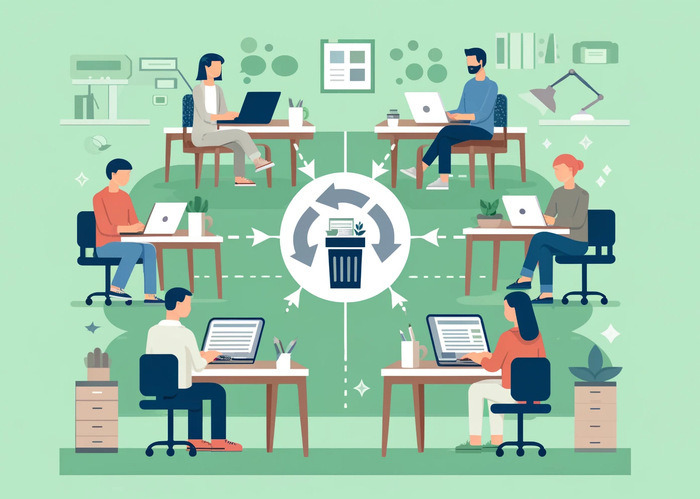
In the ever-changing world of digital content, the idea of content repurposing has become a strategic cornerstone for marketers, content writers, and SEO experts alike. But what exactly is content reuse?
At its core, content reuse is the repurposing and redistribution of existing material across multiple platforms and media.
This method eliminates the need to start from scratch when developing new content and maximizes its value and reach.
In a digital age where content is king, the ability to effectively recycle and adapt content can be a game changer. Not only does it save time and resources, it also increases online visibility and engagement. By reusing content, brands can deliver their message consistently and reinforce their identity.
The benefits of repurposing content are numerous. It results in a more effective content strategy, where resources are used wisely and no effort is wasted. It also helps with SEO by keeping material up-to-date on the website, which is favored by search engines. It also provides an opportunity to engage with new audiences who may not have seen the material or who use other media.
In the following sections, we will explore the best practices for content reuse to ensure that your content survives, but thrives in the digital ecosystem.
Understanding Content Reuse
Content reuse is a broad term that encompasses a variety of techniques, each with unique objectives and subtleties. It is crucial to distinguish between content reuse, repurposing, and recycling to fully understand its scope.
Content reuse is the straightforward use of existing content in different contexts or formats. For example, you might repurpose a blog post, create an eBook or a series of social networking messages. The original meaning and structure of the article is largely retained.
Content repurposing, on the other hand, involves changing the content to serve a new purpose or target a different audience. It may involve turning a webinar into a series of instructional videos or a how-to manual to revitalize and broaden the audience for the material.
Content recycling means taking outdated or underperforming content and updating it to make it fresh and relevant again. This could mean revising the infographics or updating the statistics in an outdated article.
When it comes to the types of content that can be reused, the possibilities are almost endless. Here are a few examples:
- Blog posts can be turned into infographics, podcasts, or video scripts.
- Case studies can be summarized for social media or detailed in whitepapers.
- Webinars can be repackaged into educational series or training modules.
- Infographics can be broken down into slide decks or expanded into blog posts.
The role of content audits is pivotal in identifying which pieces of content are suitable for reuse. A content audit is a thorough review of all the content produced by your organization, assessing its performance and relevance. The aim of a content audit is to discover:
- Evergreen content that continues to attract traffic and can be repurposed.
- Outdated content that can be updated and recycled.
- High-performing pieces that can be reformatted and reused across different platforms.
By conducting regular content audits, organizations can maintain a repository of valuable content that can be reused time and time again, ensuring that no piece of content goes to waste.
Best Practices for Content Reuse
Reusing content helps you precisely accomplish your business goals and magnify your message in addition to saving time. Reusing content effectively should cover things like strategic planning, content adaptation, quality assurance, and technology utilization.
Strategic Planning
Strategic planning lays the foundation for successful content reuse. It involves:
- Aligning content reuse with business objectives. Reusing material should always have a purpose that is in line with your larger business goals, whether it is to educate customers, build brand awareness, or increase sales.
- Identifying target audience and platforms. Understand who your audience is and where they spend their time. Content that resonates on one platform may not perform as well on another, so choose wisely to maximize impact.
Content Adaptation
Adapting content for reuse is an art. It requires:
- Tailoring content for different platforms and formats. A blog post can become a presentation deck, a series of tweets or even a video script. You need to adapt to the specific language and content standards of each platform.
- Updating statistics and information to keep content current. Outdated content can damage your credibility. To keep your material up to date, regularly update it with the latest statistics and trends.
Quality Assurance
Quality is non-negotiable. To ensure it, you need to take the following actions:
- Maintain brand voice and consistency. Your content should always reflect your brand’s voice and values, no matter where it appears. Consistency builds trust and recognition.
- Ensure legal compliance and avoid plagiarism. Always acknowledge sources and obtain the necessary permissions. Plagiarism can damage your reputation and result in legal action.
Technology Utilization
Technology can be a powerful ally in the reuse of content.
- Leverage content management systems. Use CMS tools to store, organize, and tag content for easy retrieval and reuse. This can streamline your workflow and save valuable time.
- Use analytics to measure content performance. Analytics provide insight into which content performs best, helping you make informed decisions about what to reuse and how to adapt it.
These best practices will help you create a content reuse strategy that not only extends the life of your content, but also increases its effectiveness in meeting your business objectives.

Ways to Implement Content Reuse
Let us now illustrate how content reuse strategies can, in theory, be adopted and implemented by different organizations.
A Global Software Company’s Whitepaper Transformation
A well-known software company had produced a comprehensive study of cybersecurity trends. They turned the whitepaper into a series of blog posts, each focusing on a different facet of cybersecurity, in order to broaden its audience. They also organized a webinar to explore the findings of the whitepaper in more detail, and produced an infographic that summarized key data and trends. This multi-channel approach resulted in a 50% increase in lead generation compared to their previous campaigns.
A Non-Profit’s Video Content Recycling
A non-profit dedicated to environmental conservation had a collection of interviews and documentaries. They repurposed this content into short, high-impact social media clips that were distributed across a variety of platforms with targeted messaging. This tactic led to a 30% increase in volunteer registrations and helped them target a younger demographic, as well as increasing the visibility of their material.
A Fashion Retailer’s User-Generated Content Campaign
A fashion retailer encouraged customers to post pictures of themselves wearing the brand’s clothes. The best submissions were used as in-store displays and highlighted in the web gallery and promotional emails. This strategy increased sales by 20% during the campaign period by attracting new customers as well as engaging the existing customer base.
An Educational Institution’s Course Material Update
A university had a series of popular online courses. They updated the course materials and repurposed them into micro-learning modules available on mobile platforms. This initiative allowed them to tap into the growing market of mobile learners and resulted in a 40% increase in enrollments for their online programs.
These stories demonstrate that through strategic repurposing, organizations can effectively extend the life of their content, reach new audiences, and achieve significant outcomes. By refreshing and redistributing existing materials, they can enhance engagement, maintain brand consistency and achieve greater return on investment.
ClickHelp as a Content Reuse Tool
ClickHelp is a comprehensive documentation platform that can be highly effective for content reuse. It offers a range of features that facilitate the efficient management and reuse of content. Here is how ClickHelp can be used as a content reuse tool:
- Centralized content repository. ClickHelp acts as a centralized hub for all your documentation, making it easier to find and manage existing content. This repository can be invaluable in identifying content that can be reused or repurposed.
- Topic linking and reuse. ClickHelp allows you to create topics that can be linked and reused across multiple documents. This ensures consistency and saves time as updates to the original topic are automatically propagated to all linked instances.
- Conditional content. ClickHelp allows you to define conditions for content visibility. This means you can create a single source of content that can be dynamically shown or hidden based on the audience or platform, streamlining the content customization process.
- Version control. Keeping track of different versions of your content is crucial for effective reuse. ClickHelp’s version control capabilities ensure that you always have access to previous versions, which can be helpful when updating or repurposing content.
- SEO and analytics. ClickHelp includes SEO features to help your content rank better in search engines, as well as analytics to track how your content is performing. This data can help you decide what content to reuse and how to optimize it for different platforms.
- Collaboration tools. Content reuse often requires teamwork. ClickHelp’s collaboration features, such as commenting and review workflows, make it easy to work together on content reuse.
- Export and publishing options. ClickHelp supports multiple export formats and publishing options, allowing you to easily customize and distribute your content across different channels and formats.
With these features ClickHelp can significantly enhance your content reuse strategy and ensure that your content remains consistent, up-to-date, and aligned with your business goals.
![]()
Conclusion
In the ever-evolving digital world, the ability to reuse content can significantly amplify your message and extend the life of your original material. By mastering the techniques of content repurposing, you can engage your audience with a fresh perspective, maintain a cohesive brand narrative across platforms, and increase the value of your content investments. This approach not only boosts engagement, but also streamlines your content creation process, allowing for a more efficient allocation of resources.
As we look to the future, the ability to intelligently repurpose content will be a key differentiator for businesses. Those who can innovate in content reuse will lead the way in capturing audience attention and establishing thought leadership.
Good luck with your technical writing!
ClickHelp Team
Author, host and deliver documentation across platforms and devices

